< Previous | Contents | Next >
He Crowned Our Most Pathetic King
SIBTHORPE. This bare little village has a few fine things to treasure, and the memory that one of its sons crowned one of our kings.
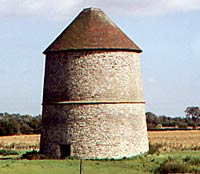
Sibthorpe dovecote in 2003.
For 700 years a fine stone dovecot, nearly 100 feet round and with over 1000 nests, has stood near the church and seen Sibthorpe's great days come and go. The big house is no more, and the glory of the church has waxed and waned. It grew into a fine collegiate church after Thomas de Sibthorpe founded his chantry here about 1325, and was given by Henry the Eighth (with all its lands) to Richard Whalley and Thomas Magnus.
Magnus was a benefactor of Newark and friend of Wolsey. It is said that after his downfall the Cardinal asked if he could stay with him at Sibthorpe, and a letter from Magnus, still extant, explains that his house had but poor accommodation, so that whether or not Wolsey came is uncertain.
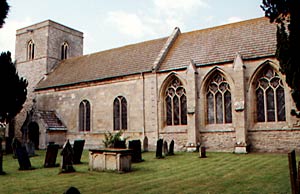
Sibthorpe church in 2003.
There are twenty Irish yews in sombre formation by the small church, so oldfashioned that it is still lit with candles. It has lost the north aisle and the chapel where masses were sung, but the arches of the old arcade are still seen in the wall. The sturdy tower of about 1300 has a modern parapet, and Georgian work is in the nave and the porch. The beautiful 14th century chancel has windows with leaf tracery, and its lofty 13th century arch rests on shafts with foliage capitals.
Over a founder's recess in the chancel is an elaborately carved Easter Sepulchre, showing four Roman soldiers crouching in their sleep and Our Lord risen, with two adoring angels. The font is 17th century, a plain little chest is over 500 years old, and there are solid oak benches a century younger. In the sanctuary is an old chair.
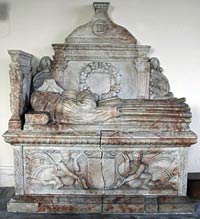
Edward Burnell's tomb in 2007. © Copyright Richard Croft and licensed for reuse under this Creative Commons Licence.
On a magnificent alabaster tomb lies the Elizabethan figure of Edward Burnell, wearing a ruff and a gown opened to show the tunic and breeches; his head rests on a book, he holds another in his uplifted hands, and his feet are on a weird skull. It was erected by his widow Barbara; she also set up the fine monument in Screveton to Richard Whalley, whose third wife she was before marrying Burnell. The man who crowned the king was Thomas Secker, born here in 1693, the son of a nonconformist farmer. He was educated at the nonconformist academy of Timothy Jollie at Attercliffe and sent to study divinity at the expense of Isaac Watts. In 1733 he was appointed King's Chaplain, two years later he became Bishop of Bristol, then Dean of St Paul's in 1750, and finally Archbishop of Canterbury. One of the greatest of our English Primates, he was diligent, learned and amiable, and a notable preacher, and he crowned George the Third, perhaps the most pathetic monarch who ever sat on our throne.
The Forester and His Lady
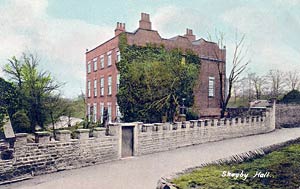
Skegby Hall, c.1905.
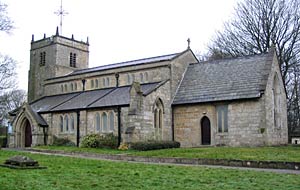
Skegby church in 2008.
SKEGBY. The village has grown on the steep sides of a valley, and its church stands high at one end, looking down on the big house.
Much of the old church has been lost in the rebuilding made necessary by the mine running under it, but there is old work left in the base of the tower, a 13th century arcade in the nave, and a tiny 700-year-old piscina which has a woman's face carved on the drain. Built into the walls inside and out are 12th and 13th century coffin stones, carved with crosses, a chalice, a sword, and shears; one is only 27 inches long. A medieval stone on the wall has on it a kneeling priest.
The treasures here are two fine stone figures, once lying down but now standing against a wall. One is a lady with a wimple and a long gown, her hands in prayer and her head on a cushion held by angels; the other is a forester with his hunter's horn. They are thought to be Edmund Spigurnell of 1296 and his wife. Part of their home still survives in the 12th and 13th century remains in the ruined building by a farmhouse near the station.
An engraved brass to John Miller who was killed at Suvla Bay "at daybreak" in 1915, has two angels holding the inscription:
And to keep loyalties young,
I'll write his name golden for ever.
The Face in the Ruff
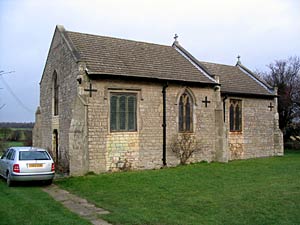
Sookholme church in 2008.
SOOKHOLME. A tiny village with a simple church all neat and trim, it has its share of Norman England in a wide chancel arch with roll mouldings and a font bowl shaped like a bucket. It has lost a third of its old length, but there is still much Norman masonry in the north and south walls, and a few windows are medieval. A fine piscina and a crude stone bench for the priests are 600 years old. There is an old chest, and the nave roof has two fine old beams and two ancient bosses, one carved with a quaint face with a pointed ruff all round it.
